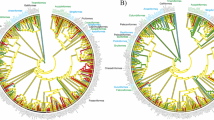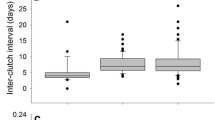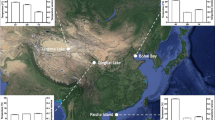Abstract
Female birds can potentially utilise various mechanisms, such as intraclutch egg size variation (ICESV), to modulate offspring quality. If this represents an ‘adaptive’ strategy allowing females to adjust reproductive effort after laying of the first egg, as information on resources becomes more predictable later in the laying sequence, then we would predict that ICESV would vary with ecological context, e.g. in ‘good’ versus ‘bad’ years. Here, in European Starlings (Sturnus vulgaris), we tested specific predictions that (1) females would lay relatively small last laid eggs in ‘poor’ years (with early laying and below-average breeding productivity); and (2) that ICESV would be lower in good years (late laying, above-average productivity) so that late-hatched chicks would not be disadvantaged. At the individual level we predicted (3) that repeatability of ICESV would be low if females adjusted this in relation to the environment in different years; and (4) that within-individual variation in ICESV should correlate with the number, and timing, of loss of chicks. Mean ICESV averaged −1.9% (measured as last egg mass relative to mean egg mass), typical of other hole-nesting passerines. However, our results did not support any of our hypotheses: (1) although there was annual variation in ICESV, in all years egg mass decreased through the laying sequence; (2) annual variation in ICESV was not consistent with variation in phenology or breeding productivity among years; (3) marked individual variation in ICESV (last laid egg varied from −20 to +10% relative to mean egg mass within clutches) was repeatable, i.e. individual females did not adjust ICESV in subsequent breeding attempts; and (4) variation in the magnitude of ICESV, alone and combined with hatching asynchrony, did not predict early brood loss. Our study suggests that ICESV is a relatively inflexible component of an individual female’s phenotype that might contribute to variation in individual quality.
Zusammenfassung
Die Variation der Eigröße innerhalb des Geleges ist bei Staren Sturnus vulgaris im Jahresvergleich unabhängig vom ökologischen Kontext
Vogelweibchen stehen potenziell verschiedene Mechanismen zur Verfügung, mit denen sie die Qualität des Nachwuchses anpassen können, so zum Beispiel die Variation der Eigröße innerhalb des Geleges (=intraclutch egg size variation; ICESV). Falls diese eine “adaptive” Strategie darstellt, welche es den Weibchen erlaubt, den Reproduktionsaufwand nach Ablage des ersten Eies nachzuregulieren, wenn im späteren Legeverlauf Informationen über Ressourcen berechenbarer werden, dann würden wir vorhersagen, dass sich die ICESV mit dem ökologischen Kontext ändert, beispielsweise in “guten” gegenüber “schlechten” Jahren. Hier überprüften wir an Staren Sturnus vulgaris bestimmte Vorhersagen, nämlich dass (a) die Weibchen in “schlechten” Jahren (mit späten Legedaten und unterdurchschnittlicher Brutproduktivität) relativ kleine letzte Eier legen sowie dass (b) die ICESV in “guten” Jahren (mit frühen Legedaten und überdurchschnittlicher Brutproduktivität) niedriger ist, so dass spät geschlüpfte Küken keinen Nachteil haben. Auf Individuenebene sagten wir voraus, dass (c) die Reproduzierbarkeit der ICESV niedrig sein müsse, falls die Weibchen diese in Bezug auf die Umwelt in verschiedenen Jahren anpassen und dass (d) die individuenbezogene Variation der ICESV mit Anzahl und Zeitpunkt von Kükenverlusten korrelieren sollte. Im Durchschnitt betrug die ICESV -1,9% (gemessen als Masse des letzten Eies im Vergleich zum Mittelwert), was typisch für höhlenbrütende Singvögel ist. Unsere Ergebnisse bestätigten dagegen keine unserer Hypothesen: (a) obwohl die ICESV von Jahr zu Jahr variierte, nahm in allen Jahren die Eimasse im Legeverlauf ab; (b) die Unterschiede in der ICESV von Jahr zu Jahr deckten sich nicht mit der jahresbezogenen Variation in der Phänologie oder der Brutproduktivität; (c) die deutliche individuelle Variation der ICESV (das zuletzt gelegte Ei wich zwischen −20 und +10% von der mittleren Eimasse der Gelege ab) war reproduzierbar, das heißt, die einzelnen Weibchen passten die ICESV bei folgenden Brutversuchen nicht an; und (d) die Variation in der Ausprägung der ICESV, sowohl einzeln als auch in Kombination mit asynchronem Schlüpfen, lieferte keine Vorhersagen über frühe Brutverluste. Unsere Studie lässt darauf schließen, dass die ICESV eine relativ unflexible Komponente des Phänotyps des jeweiligen Weibchens darstellt, der zur Variation der individuellen Qualität beitragen könnte.




Similar content being viewed by others
References
Antikainen E (1978) The breeding adaptation of the Jackdaw Corvus monedula L. in Finland. Savonia 2:1–45
Ardia DR, Cooper CB, Dhondt AA (2006) Warm temperatures lead to early onset of incubation, shorter incubation periods and greater hatching asynchrony in Tree Swallows Tachycineta bicolor at the extremes of their range. J Avian Biol 37:137–142. doi:10.1111/j.0908-8857.2006.03747.x
Blount JD, Houston DC, Møller AP (2000) Why egg yolk is yellow. Trends Ecol Evol 15:47–49. doi:10.1016/S0169-5347(99)01774-7
Bosman DS (2014) Effects of intraclutch variation in egg size and hatching asynchrony on nestling development and survival in semi-precocial Herring Gulls. J F Ornithol 85:379–390. doi:10.1111/jofo.12077
Christians JK (2002) Avian egg size: variation within species and inflexibility within individuals. Biol Rev Camb Philos Soc 77:1–26. doi:10.1017/S1464793101005784
Clark AB, Wilson DS (1981) Avian breeding adaptations: hatching asynchrony, brood reduction, and nest failure. Q Rev Biol 56:253–277. doi:10.1086/412316
Clutton-Brock TH (1991) The evolution of parental care. Princeton University Press, NJ
Cornell A, Gibson KF, Williams TD (2017) Physiological maturity at a critical life-history transition and flight ability at fledging. Funct Ecol 31:662–670. doi:10.1111/1365-2435.12777
Cuervo JJ, Møller AP (1999) Phenotypic variation and fluctuating asymmetry in sexually dimorphic feather ornaments in relation to sex and mating system. Biol J Linn Soc 68:505–529. doi:10.1111/j.1095-8312.1999.tb01186.x
Deeming DC (2002) Avian incubation. Oxford University Press, Oxford
Evans PGH (1988) Intraspecific nest parasitism in the European Starling Sturnus vulgaris. Anim Behav 36:1282–1294. doi:10.1016/S0003-3472(88)80197-0
Forbes S (2007) Sibling symbiosis in nestling birds. Auk 124:1–10. doi:10.1642/0004-8038(2007)124[1:SSINB]2.0.CO;2
Forbes S (2009) Portfolio theory and how parent birds manage investment risk. Oikos 118:1561–1569. doi:10.1111/j.1600-0706.2009.17702.x
Forbes LS, Mock DW (1996) Food, information, and avian brood reduction. Ecoscience 3:45–53
Forbes S, Thornton S, Glassey B et al (1997) Why parent birds play favourites. Nature 390:351–352. doi:10.1038/37025
Forbes S, Glassey B, Thornton S, Earle L (2001) The secondary adjustment of clutch size in Red-winged Blackbirds (Agelaius phoeniceus). Behav Ecol Sociobiol 50:37–44. doi:10.1007/s002650100332
Fronstin RB, Christians JK, Williams TD (2015) Experimental reduction of haematocrit affects reproductive performance in European Starlings. Funct Ecol. doi:10.1111/1365-2435.12511
Greig-Smith PW, Feare CJ, Freeman EM, Spencer PL (1988) Causes and consequences of egg-size variation in the European Starling Sturnus vulgaris. Ibis 130:1–10. doi:10.1111/j.1474-919X.1988.tb00950.x
Hipfner JM, McFarlane-Tranquilla LA, Addison B (2008) Do marine birds use environmental cues to optimize egg production? An experimental test based on relaying propensity. J Avian Biol 39:611–618. doi:10.1111/j.1600-048X.2008.04355.x
Järvinen A, Ylimaunu J (1986) Intraclutch egg-size variation in birds: physiological responses of individuals to fluctuations in environmental conditions. Auk 103:235–237
Jover L, Ruiz X, González-Martín M (1993) Significance of intraclutch egg size variation in the Purple Heron. Ornis Scand 24:127–134. doi:10.2307/3676362
Karlsson J (1983) Breeding of the Starling (Sturnus vulgaris). University of Lund
Kessel B (1957) A study of the breeding biology of the European Starling (Sturnus vulgaris L.) in North America. Am Midl Nat 58:257–331. doi:10.2307/2422615
Kontiainen P, Pietiainen H, Huttunen K et al (2009) Aggressive Ural owl mothers recruit more offspring. Behav Ecol 20:789–796. doi:10.1093/beheco/arp062
Love OP, Wynne-Edwards KE, Bond L, Williams TD (2008) Determinants of within- and among-clutch variation in yolk corticosterone in the European Starling. Horm Behav 53:104–111. doi:10.1016/j.yhbeh.2007.09.007
Maddox JD, Weatherhead PJ (2008) Egg size variation in birds with asynchronous hatching: is bigger really better? Am Nat 171:358–365. doi:10.1086/527500
Magrath RD (1990) Hatching asynchrony in altricial birds. Biol Rev 65:587–622. doi:10.1111/j.1469-185X.1990.tb01239.x
Matthysen E, Adriaensen F, Dhondt AA (2011) Multiple responses to increasing spring temperatures in the breeding cycle of blue and Great Tits (Cyanistes caeruleus, Parus major). Glob Chang Biol 17:1–16. doi:10.1111/j.1365-2486.2010.02213.x
Meijer T, Drent R (1999) Re-examination of the capital and income dichotomy in breeding birds. Ibis 141:399–414. doi:10.1111/j.1474-919X.1999.tb04409.x
Mock DW, Parker GA (1997) The evolution of sibling rivalry. Oxford University Press, Oxford
Monaghan P, Nager RG (1997) Why don’t birds lay more eggs? Trends Ecol Evol 12:270–274. doi:10.1016/S0169-5347(97)01094-X
Murphy MT (1994) Breeding patterns of Eastern Phoebes in Kansas: adaptive strategies or physiological constraint? Auk 111:617–633
Ojanen M, Orell M, Vaisanen MA (1981) Egg size variation within passerine clutches: effects of ambient temperature and laying sequence. Ornis Fenn 58:93–108
R Core Team (2016) R: a language and environment for statistical computing. https://www.r-project.org/
Remeš V (2005) Nest concealment and parental behaviour interact in affecting nest survival in the Blackcap (Sylvia atricapilla): an experimental evaluation of the parental compensation hypothesis. Behav Ecol Sociobiol 58:326–332. doi:10.1007/s00265-005-0910-1
Robertson GJ (1995) Annual variation in common eider egg size: effects of temperature, clutch size, laying date, and laying sequence. Can J Zool 73:1579–1587. doi:10.1139/z95-188
Schwagmeyer PL, Mock DW (2008) Parental provisioning and offspring fitness: size matters. Anim Behav 75:291–298. doi:10.1016/j.anbehav.2007.05.023
Slagsvold T, Sandvik J, Rofstad G et al (1984) On the adaptive value of intralcutch egg-size variation in birds. Auk 101:685–697
Sockman KW, Sharp PJ, Schwabl H (2006) Orchestration of avian reproductive effort: an integration of the ultimate and proximate basis of flexibility in clutch size, incubation behaviour, and yolk androgen deposition. Biol Rev 81:629–666
Sydeman WJ, Eddy JO (1995) Repeatability in laying date and its relationship to individual quality for Common Murres. Condor 97:1048–1052. doi:10.2307/1369543
Sydeman WJ, Emslie SD (1992) Effects of parental age on hatching asynchrony, egg size and third-chick disadvantage in Western Gulls. Auk 109:242–248. doi:10.2307/4088192
Weidinger K (2002) Interactive effects of concealment, parental behaviour and predators on the survival of open passerine nests. J Anim Ecol 71:424–437. doi:10.1046/j.1365-2656.2002.00611.x
Williams TD (1994) Intraspecific variation in egg size and egg composition in birds: effects on offspring fitness. Biol Rev Camb Philos Soc 68:35–59. doi:10.1111/j.1469-185X.1994.tb01485.x
Williams TD (2005) Mechanisms underlying the costs of egg production. Bioscience 55:39–48. doi:10.1641/0006-3568(2005)055[0039:MUTCOE]2.0.CO;2
Williams TD (2012) Physiological adaptations for breeding in birds. Princeton University Press, NJ
Williams TD, Jeffs C, Murray KA, Choudhury S (1996) Intraclutch egg-size variation in the Barnacle Goose Branta leucopsis: an egg-removal experiment. Ibis 138:499–505. doi:10.1111/j.1474-919X.1996.tb08070.x
Williams TD, Bourgeon S, Cornell A et al (2015) Mid-winter temperatures, not spring temperatures, predict breeding phenology in the European Starling Sturnus vulgaris. R Soc Open Sci. doi:10.1098/rsos.140301
Wilson AJ, Nussey DH (2010) What is individual quality? An evolutionary perspective. Trends Ecol Evol 25:207–214. doi:10.1016/j.tree.2009.10.002
Acknowledgements
We would like to thank the many post-doctoral students, graduate students and undergraduate students who have contributed to data collection in this project since 2002, especially Oliver Love, Sophie Bourgeon, Raime Fronstin, Allison Cornell, and Melinda Fowler. This work was funded by Natural Sciences and Engineering Research Council of Canada Discovery and Accelerator Grants to T. D. W. and a Simon Fraser University Undergraduate Student Research Award to K. F. G. All the work was conducted under a Simon Fraser University Animal Care permit (no. 1018B-96) following guidelines of the Canadian Council on Animal Care.
Author information
Authors and Affiliations
Corresponding author
Ethics declarations
Funding
This study was funded by Natural Sciences and Engineering Research Council of Canada Discovery (no. 155395-2012) and Accelerator (no. 429387-2012) Grants to T. D. W. and a Simon Fraser University Undergraduate Student Research Award to K. F. G.
Conflict of interest
The authors declare that they have no conflict of interest.
Ethical approval
This article does not contain any studies with human participants performed by any of the authors. All applicable international, national, and/or institutional guidelines for the care and use of animals were followed.
Additional information
Communicated by F. Bairlein.
Rights and permissions
About this article
Cite this article
Gibson, K.F., Williams, T.D. Intraclutch egg size variation is independent of ecological context among years in the European Starling Sturnus vulgaris . J Ornithol 158, 1099–1110 (2017). https://doi.org/10.1007/s10336-017-1473-4
Received:
Revised:
Accepted:
Published:
Issue Date:
DOI: https://doi.org/10.1007/s10336-017-1473-4




